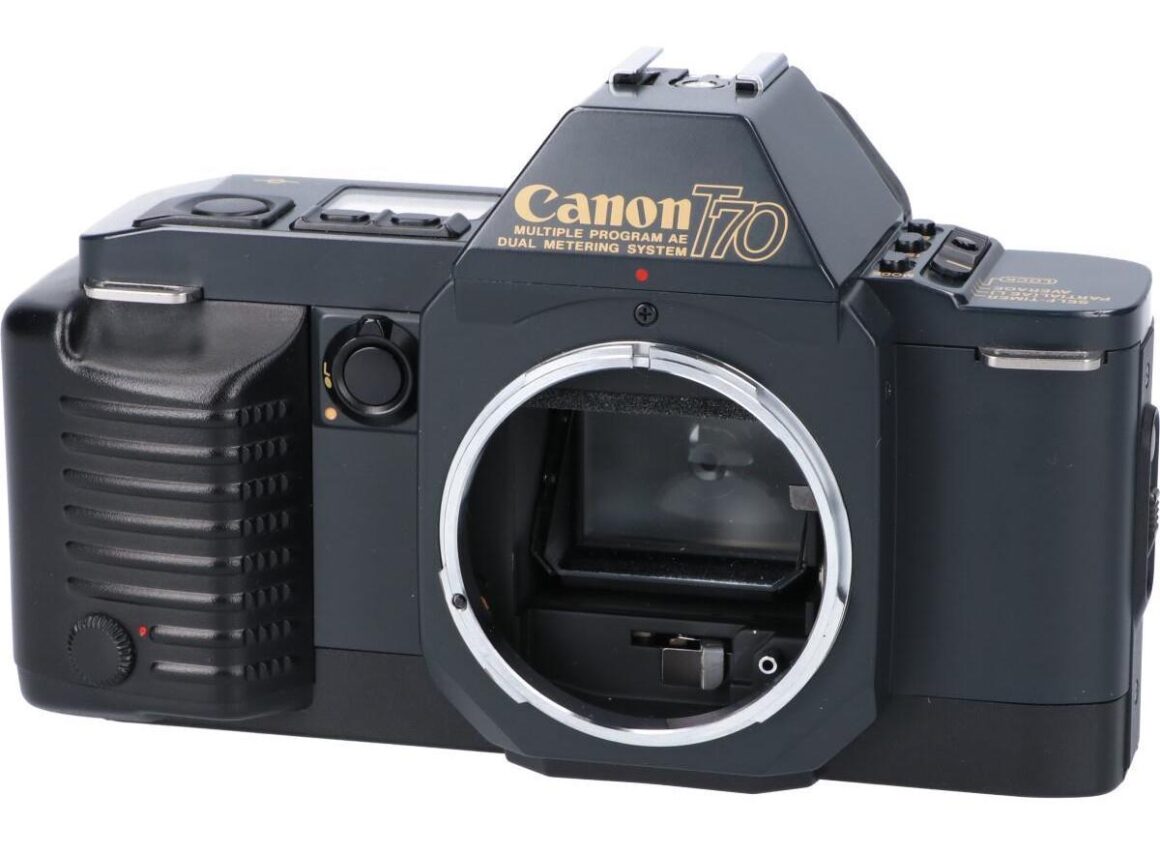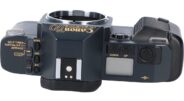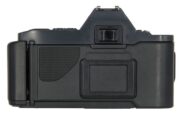Canon T70
35mm MF film SLR camera • Discontinued
- Announced:
- · April 1984
- Production status:
- ● Discontinued
- Country of design:
- · Japan
- System:
- · Canon FD (1971)
Specification
| Format: | |
| 35mm full frame | |
Film type: | 135 cartridge-loaded film |
| Canon FD [42mm] | |
| Shutter: | |
Type: | Focal-plane |
Model: | Electronically controlled |
Speeds: | 2 - 1/1000 + B |
| Exposure: | |
Exposure metering: | Through-the-lens (TTL), open-aperture |
Exposure modes: | Programmed Auto |
| Shutter-priority Auto | |
| Manual | |
| Physical characteristics: | |
Weight: | 530g |
Dimensions: | 151x89.2x48.4mm |
Manufacturer description #1
The second T-series camera. The camera kit included an FD 35-70mm f/3.5-4.5 lens or an FD 28-55mm f/3.5-4.5.
The large LCD panel and key-touch buttons had a major impact on 35mm SLR cameras that followed. The T70 features shutter speed-priority TTL AE, TTL multi-program AE, and preset aperture AE. The dual metering system gives a choice of centerweighted averaging metering and partial metering at the center. In 1984, the camera won the Good Design Award (from the Ministry of International Trade and Industry) and the European Camera of the Year Award.
Manufacturer description #2
The T70 is the second in the new T-series of Canon SLRs. Similar in appearance to the T50, with the same off-center pentaprism and sleek, low-profile design, the T70 draws on the latest advances in microprocessor technology to provide a host of sophisticated functions. These include multiple program AE modes, shutter-priority AE, manual override, stopped-down AE and dual metering. A dedicated accessory, the Command Back 70, functions as a combined data back/interval timer. Film loading worries are eliminated by a built-in motor which carries out automatic first frame setting, auto-wind/rewind and continuous shooting.
Multiprogram AE
The T70 meets the need for greater flexibility in programmed photography with three daylight program modes and programmed electronic flash. Each mode is designed to match a specific photographic situation as well as the lens in use. All the programs, however, can be used with any lens.
Standard Program AE
This program is suitable when there is plenty of light and/or when a large maximum aperture lens is used. It selects moderately fast shutter speeds and is ideal for portraiture or snapshots with lenses in the wide-angle to short telephoto range. The viewfinder's P mark flashes as a camera-shake warning (below 1/60 sec).
Wide Program AE
When depth of field is important, switch to this program. The Wide Program increases depth of field by choosing smaller apertures over faster shutter speeds. Especially effective with wide-angle and standard lenses, it gives the photographer more opportunity for creative expression when shooting scenics, group pictures, interiors, etc. The P mark blinks at speeds below 1/30 sec.
Tele Program AE
The Tele Program selects the fastest shutter speed possible under the prevailing lighting conditions. Maximum aperture is maintained up to approx. 1/250 sec. Although effective at all focal lengths, the Tele Program is the ideal program mode for arresting rapid subject motion and minimizing image blur when using telephoto lenses. Camera-shake warning is given at speeds below 1/125 sec.
Shutter-priority AE
For sports and other types of action photography, the T70 offers shutter-priority AE. Shutter speed selection is made by pressing the shift buttons while in the Tv mode. If the light level exceeds the maximum or minimum lens aperture, the T70's special shift function comes into play and the camera switches automatically to a higher or lower speed.
Manual mode
The multiprogrammed T70 is not exclusively automatic. It also provides full manual operation when the need arises. Metering is performed at full aperture and the reading is displayed in the viewfinder. Exposure warnings are also issued whenever necessary.
Time exposure countdown
Time exposures can be made with quartz accuracy. With the shutter speed at "bulb", release the shutter. The frame counter converts to a stopwatch and counts to 30 seconds repeatedly. Dashes mark the 30 sec increments for an accurate record of timed exposures up to 2 minutes long.
Stopped-down AE
Stopped-down AE is another T70 advantage. Canon accessories such as bellows and extension tubes can be attached for close-up and photomacrography uses. Select stopped-down AE by pressing the AE mode selector and either shift button. An aperture mark on the LCD signifies the mode. Now choose an aperture, focus and shoot. The T70 will select the correct shutter speed with computerized accuracy.
Selectable metering
The T70 user can meter the scene with either of two systems: Center-weighted average metering or Selective area metering. This unique feature enables the photographer to choose the metering method that is most appropriate for the subject lighting and lens in use; Greater exposure accuracy is the result. Metering mode selection is made by a simple slide switch. At the heart of the system is a highly sensitive SPC with two independent photosensitive areas that are switched electronically to change the metering pattern.
Center-weighted average metering
This system is suitable for uniformly illuminated scenes without bright highlights. Sensitivity is concentrated on the central picture area where the subject is generally positioned and diminishes toward the edges.
Selective area metering
Strongly backlit subjects tend to come out underexposed when average-metered. Selective area metering solves this problem by limiting metering sensitivity to the central 11% of the image area. This metering pattern offers a more accurate reading with telephoto lenses. An AE lock is available for off-center subjects. Take a reading close up then press the shutter button halfway or press the exposure preview button to lock exposure. The system functions in shutter-priority AE and the program modes.
Full-information viewfinder
Exposure data and warnings are displayed when required to the right ofthe image. The bright laser matte screen's New Split microprism collar is encircled by the selective area metering zone mark.
Built-in motor
Motor driven film advance is an integral feature of the T70. The T70's auto-load function takes the worry out offilm loading. Insert a cartridge and draw the film across to the orange mark. Close the back and the camera fIres off several blank shots until it reaches the fIrst frame position. The film advances automatically upon shutter release. Continuous shooting (at 1.2 frames per sec) is also possible. At film end, a rapid beeping sounds and the LCD flashes. For auto-rewind, slide the release switch and press the rewind button.
Programmed flash
Flash photography is also programmed. A new Speedlite, the 277T, sets the aperture and 1/90 sec sync speed automatically when in the program mode. Press the shutter button gently and the unit fires a low-intensity infrared preflash to measure the distance. The subject reflectivity and the ambient lighting are both computed. The aperture chosen by the flash is indicated in the viewfinder and on the 277T's back panel. lf the subject is too far away, a warning is issued in the viewfinder. A full range of automatic apertures and a more powerful GN expand the flash opportunities in darkness and for fill-in light in daylight. In the F.NO.SET mode, the choice of 8 apertures allows greater control of depth offield and faster recycling time. The 277T's push buttons, LED aperture indicators and forward-tilted design match the T70's futuristic image.
Comprehensive safety functions
Supporting the T70's advanced features and functions is a comprehensive system of monitoring and control devices. User-operable are the back cover latch, rewind button, mode selector and Tv shift locks. The microcircuitry includes such safety features as the shutter-priority AE safety shift function, circuitry protection against reversed battery loading, viewfinder warnings and LCD data including film loading/transport status and battery check. The circuitry scale is several times as great as in the A-1, yet the T70 consumes little energy. Power is provided by two penlight batteries. Contributing to the power-conserving design are the light-load EMAS shutter and low energy consuming time exposure mode. An hourly battery check is made automatically during long exposures.
Canon FD lenses
Being an SLR, the T70 can be used with any lens in the FD range. The system now numbers over 50, from fish-eye to super-telephoto. Each offers superior sharpness, uniform color balance and outstanding handling. Lens changing is rapid and sure thanks to the breech-lock mount. Precision alignment of signals and levers plus elimination ofmount wear are further compelling reasons to choose a Canon lens over other brands.
The T70 lends itself to use with zoom lenses. There are 16 zooms, covering every focal length from 24mm to 600mm. Excellent all-purpose lenses are the New FD 28-55mm and FD 35-70mm, both with a maximum aperture of f/3.5-4.5. The FD 80-200mm f/4 is a popular lens for sports and wildlife photography.
Manufacturer description #3
Type: 35 mm single lens reflex (SLR) camera with electronically controlled automatic exposure (AE) and focal-plane shutter. Wind/rewind fully automatic.
Format: 24 x 36 mm
Exposure modes: Multiprogram AE (Standard program, Tele program, Wide program), shutter-priority AE with safety shift function, manual, stopped-down AE (only for lenses without AE signal pins), program flash AE and electronic flash AE (with Canon Speedlite 277T).
Usable lenses: Canon FD lenses (full aperture metering) and non-FD lenses (stopped-down metering).
Viewfinder: Fixed eye-level pentaprism without condenser. Gives 92% vertical and horizontal coverage of actual picture area and 0.85x magnification at infinity with a standard 50 mm lens
Finder information: Displayed to the right of viewing area. 4 point LED: P lights up steadily when camera is in the program mode and exposure is correct. Flashes at 2 Hz to give camera-shake warning. * lights to indicate AE lock. ↯ lights when the flash is fully charged. M flashes at 4 Hz to indicate manual setting. 2 digital display: Indicates aperture setting in shutter-priority AE and program AE. Indicates shutter speed setting in stopped-down AE. (High shutter speeds are abbreviated so that 1/125-1/350 sec become HL. and 1/500- 1/1000 sec become HH). Display flashes at 8 Hz to indicate over and underexposure. Display flashes at 2 Hz when safety shift function is operating during shutter-priority AE Selective area metering range mark. (In center of screen)
Dioptric adjustment: Built-in eyepiece is adjusted to standard -1 diopter.
Mirror: Quick return type with shock and noise absorber.
Eyepiece cap: Stored in the shoulder pad of the neckstrap.
Light metering system: Through-the-lens (TTL) full aperture metering (for FD lenses), using silicon photocell (SPC). Two selectable weighting patterns, center-weighted average metering and selective area metering. (Selective area metering can only be used with AE lock) (When using lenses or accessories without AE signal pins, only stopped-down metering may be used.)
Meter coupling range: With ISO 100/21°, ASA 100 film and a 50 mm f/1.4 lens: EV 1-19.
Film speed: ISO 12/12° - ISO 1600/33°, ASA 12-ASA 1600 (in 1/3 steps). Displayed on the LCD panel when pressing the ISO button.
Exposure reading: Exposure can be checked by pressing exposure preview button, or by pressing shutter button halfway.
Shutter: Vertical travel electromagnetic attraction focal-plane shutter (EMAS).
Shutter speeds: Automatic: 1/1000 sec-2 sec.
Manual: 12 settings, 1/1000, 1/500, 1/250, 1/125, 1/60, 1/30, 1/15, 1/8, 1/4, 1/2, 1, 2 sec and Bulb. (X-sync = 1/90 sec.)
Self-timer: Electronically controlled, with a delay of approx 10 sec.
Camera-shake warning: The P mark in the finder flashes at 2 Hz during program AE mode operations for the following shutter speeds: Standard program: 1/60 sec or slower, Tele program: 1/125 sec or slower, Wide program: 1/30 sec or slower.
Film loading and first frame positioning: Automatic. After the film has been positioned and the back cover closed, the film is automatically advanced to the 1st usable frame and then automatically stopped. Three blank frames are advanced. The frame counter display then reads "1".
Film wind: Automatic using built-in motor, enabling continuous shooting. Confirmation by floating bar marks on LCD panel. When the end of the film is reached, the film-load indicator and the frame counter number on the LCD panel start blinking. A beeping sound is also emitted.
Film rewind: Automatic using built-in motor. Automatic stop after film has been rewound into the cartridge. Rewind completion is indicated on LCD panel.
Frame counter: Shown on the LCD panel. Additive type with numbers 1-39, counts down during film rewind.
Back cover: Removable, with memo holder. Opened sliding latch with safety lock.
Flash contact: Coupled directly to the camera by means of the X-contact on the accessory shoe.
Automatic flash: Program flash AE: With the Speedlight 277T. After sending out an infrared pre-flash to judge the distance and the reflectivity of the subject, the 277T sets the aperture and 1/90 sec shutter speed automatically. When out of shooting distance range (too far away), a warning is given, indicated by the aperture value flashing in the viewfinder. Electronic flash AE: With the 277T in "F.NO. SET" mode, or with other Canon Speedlites, shutter speed is set automatically to X-sync and aperture to the f/stop that has been sey on the flash.
Power source: Main power source: Two AA size (3V) batteries. Alkaline batteries are standard but carbon-zinc and Ni-Cd batteries may also be used. Memory back-up: Built-in lithium battery (BR-1225 or CR-1220), battery life is approx. 5 years.
Power switch: The power is turned OFF by setting the main switch to "LOCK".
Battery check: By pressing the battery check (BC) button. Three energy levels are shown by bar marks on the LCD.
Remote control: Possible. With three-terminal contact for remote control. Remote Switch 60 T3 is required.









